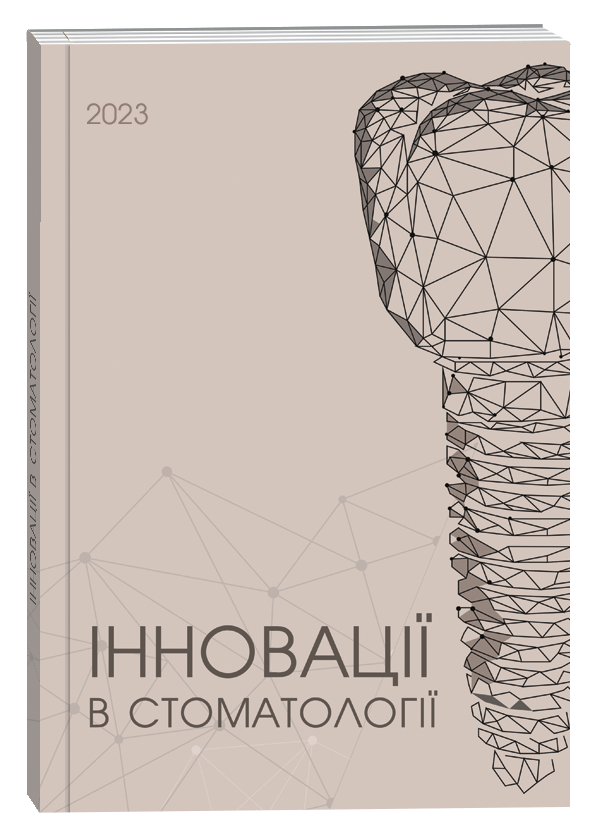ADHESIVE POTENTIAL OF ENAMEL AND DENTIN SURFACE MICRORELIEF UNDER DIFFERENT PREPARATION PROTOCOLS
DOI:
https://doi.org/10.35220/2523-420X/2025.2.2Keywords:
dentistry, teeth, dental caries, preparation, microrelief , adhesionAbstract
Aim. To assess the adhesive potential of the surface microrelief of dental hard tissues under different cavity preparation and adhesive protocols. Materials and Methods. Extracted impacted third molars were sectioned mesiodistally to obtain two halves of the crown. Depending on the preparation and conditioning protocols, four experimental groups were formed: Group 1 – rotary instrumentation without acid etching; Group 2 – rotary instrumentation with etching using 37% phosphoric acid gel; Group 3 – air-abrasion preparation without etching; Group 4 – air-abrasion preparation with acid etching. Sample surfaces were examined under an optical microscope, photographed, and imported into the opensource ImageJ software for image processing and analysis. Two-dimensional and three-dimensional surface images (microrelief profiles) were analyzed based on surface type, structure, relief features, and optical characteristics. Results. In Group 1, enamel surfaces exhibited deep grooves, burrs, and an irregular microstructure with minimal roughness and absence of micropores. The dentin surface appeared smooth with limited microcracks and partially open dentinal tubules, with a persistent smear layer. Adhesive potential was moderate due to lack of micromechanical retention and restricted tubule openness. In Group 2, enamel surfaces displayed a more pronounced microrelief with numerous micropores and voids. Dentin showed open tubules and visible collagen networks. High adhesive potential was noted due to pronounced micromechanical retention and subsequent hybridization of dentin. Group 3 showed a less aggressive enamel surface relief but with noticeable micro-roughness. Dentin surfaces were homogeneous and rough, with partially open tubules. Moderate-to-high adhesive potential was observed due to the uniformity and moderate micromechanical retention. Group 4 demonstrated the most distinct enamel microrelief with visible micropores and uniformly open dentinal tubules with a clear porous structure. This group exhibited the highest adhesive potential among all protocols. Conclusions. The most favorable microrelief conditions for adhesion were observed in Group 4. Group 2 samples also demonstrated good bonding conditions, although with less tissue openness. Group 3 samples showed satisfactory adhesive potential, which could be improved with additional etching. Group 1 surfaces were the least favorable for bonding due to minimal roughness, absence of micropores, and a smooth surface structure.
References
Perdigão J. Current perspectives on dental adhesion: (1) Dentin adhesion–not there yet. Japanese Dental Science Review. 2020. Vol. 56, №1. P. 190–207. DOI: 10.1016/j.jdsr.2020.08.004.
Noenko I., Pavlenko O., Mochalov I. Comparative study of polymerization depth of three photocomposite dental filling materials for bulk fill restoration. Eastern Ukrainian Medical Journal. 2023. Vol. 11, №2. P. 205–213. DOI:10.21272/eumj.2023;11(2):205-213.
Ferracane J.L., Lawson N.C. Probing the hierarchy of evidence to identify the best strategy for placing class II dental composite restorations using current materials. Journal of Esthetic and Restorative Dentistry. 2021. Vol. 33, №1. P. 39–50. DOI:10.1111/jerd.12686.
Ayla Y., Pişkin B., Şen B.H. In vitro evaluation of microleakage properties of etched/non-etched air-abraded and conventionally prepared cavities: A scanning electron microscopy study. Acta Stomatologica Cappadocia. 2021. Vol. 1, №1. P. 52–67. DOI:10.54995/ASC.1.1.5.
Kui A., Buduru S., Labuneț A., Sava S., Pop D., Bara I., Negucioiu M. Air particle abrasion in dentistry: an overview of effects on dentin adhesion and bond strength. Dentistry Journal. 2024. Vol. 13, №1. P. 16. DOI:10.3390/dj13010016.
Saikaew P., Sattabanasuk V., Harnirattisai C. et al. Role of the smear layer in adhesive dentistry and the clinical applications to improve bonding performance. Japanese Dental Science Review. 2022. Vol. 58. P. 59–66. DOI: 10.1016/j.jdsr.2021.12.001.
Frascaria M., Casinelli M., Mauro S. et al. Aesthetic rehabilitation in a young patient using a minimally invasive approach. A multidisciplinary case report. European Journal of Paediatric Dentistry. 2016. Vol. 17, No. 3. P. 234–238.
Yu H., Zhao Y., Li J. et al. Minimal invasive microscopic tooth preparation in esthetic restoration: a specialist consensus. International Journal of Oral Science. 2019. Vol. 11, No. 3. Article 31. DOI:10.1038/s41368-019-0057-y.
Brostek A.M., Walsh L.J. Minimal intervention dentistry in general practice. Oral Health Dent Manag. 2014. Vol. 13, No. 2. P. 285–294.
Fatima N., Mustilwar R., Paul R. et al. Minimal invasive dentistry: a review. International Journal of Health Sciences. 2022. Vol. 6, Suppl. 1. P. 13062–13077. DOI: 10.53730/ijhs.v6nS1.8280.
Graeber J.J. Microinvasive dentistry: clinical strategies and tools. London: JP Medical Ltd, 2020. 212 p.
Majeed M.M., Al-Taee L.A. Microinvasive treatment modalities in operative dentistry. University of Baghdad College of Dentistry, 2023. 32 p. URL: https://codental.uobaghdad.edu.iq/wp-content/uploads/sites/14/2023/12/Maha-Maaroof.pdf.
Szerszeń M., Higuchi J., Romelczyk-Baishya B. et al. Physicochemical properties of dentine subjected to microabrasive blasting and its influence on bonding to self-adhesive prosthetic cement in shear bond strength test: an in vitro study. Materials. 2022. Vol. 15, No. 4. Article 1476. DOI:10.3390/ma15041476.
Kruse A.B., Burkhardt A.S., Vach K. et al. Impact of air-polishing with erythritol on exposed root dentin: a randomized clinical trial. International journal of dental hygiene. International Journal of Dental Hygiene. 2025. Vol. 23, No. 1. P. 63–72. DOI:10.1111/idh.12835.
Lima V.P., Soares K.D.A., Caldeira V.S. et al. Airborne-particle abrasion and dentin bonding: systematic review and meta-analysis. Operative dentistry. 2021. Vol. 46, No. 1. P. E21–E33. DOI:10.2341/19-216-L.
Levartovsky S., Ferdman B., Safadi N., Hanna T., Dolev E., Pilo R. Effect of silica-modified aluminum oxide abrasion on adhesion to dentin, using total-etch and self-etch systems. Polymers. 2023. Vol. 15, No. 2. Article No. 446. DOI:10.3390/polym15020446.
Метрологія, стандартизація та управління якістю : навч. посіб. / Л. П. Клименко та ін. Миколаїв : Вид-во ЧДУ ім. Петра Могили, 2011. 243 с.
International Organization for Standardization. ISO 21920-2:2021. Geometrical Product Specifications (GPS) – Surface texture: Profile: Part 2: Terms, definitions and surface texture parameters. 2021. URL: https://www.iso.org/standard/74157.html.
International Organization for Standardization. ISO 21920-1:2021. Geometrical Product Specifications (GPS) – Surface texture: Profile – Part 1: Indication of surface texture. 2021. URL: https://www.iso.org/standard/74156.html.
Özcan M., Volpato C.A.M. Current perspectives on dental adhesion:(3) Adhesion to intraradicular dentin: Concepts and applications. The Japanese Dental Science Review. 2020. Vol. 56, № 1. P. 216–223. DOI:10.1016/j.jdsr.2021.12.001.
Soliman A., Rabie M., Hassan H.Y. Smear layer removal by 1% phytic acid after root canal preparation with three different rotary systems. Open Access Macedonian Journal of Medical Sciences. 2022. Vol. 10(D). P. 267–273. DOI:10.3889/oamjms.2022.9524.
Darzé F.M., Bridi E.C., França F.M.G., Amaral F.D., Turssi C.P., Basting R.T. Enamel and dentin etching with glycolic, ferulic, and phosphoric acids: demineralization pattern, surface microhardness, and bond strength stability. Operative Dentistry. 2023. Vol. 48, № 2. P. E35–E47. DOI:10.2341/21-143-L.
Anastasiadis K., Nassar M. The effect of different conditioning agents on dentin roughness and collagen structure. Journal of Dentistry. 2024. Vol. 148. Article ID 105222. DOI:10.1016/j.jdent.2024.105222.
Rifane T.O., Hirata R., Araújo-Neto V.G. et al. Effect of phosphoric acid etching and blasting with aluminum oxide on the enamel topography and adhesion of resin composite to intact or abraded enamel. Dental Materials. 2024. Vol. 40, № 11. P. e102–e111. DOI:10.1016/j.dental.2024.08.003.
Nihalani H., Borkar A.C., Shetty S.S. et al. Comparative evaluation of different surface pretreatment methods on the depth of penetration of adhesive resin in sandwich technique: A confocal laser scanning microscopy study. Journal of Conservative Dentistry and Endodontics. 2024. Vol. 27, № 6. P. 644–648. DOI:10.4103/JCDE.JCDE_329_23.








